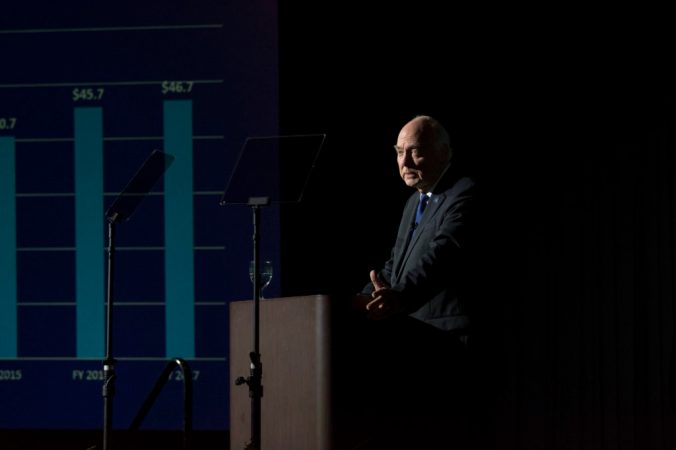
President Marc Johnson delivers the State of the University address on Tuesday, Sept. 26. Johnson hosted a Pizza with the President event for students to openly ask him questions. Photo accredited to the Nevada Sagebrush.
Originally published in The Nevada Sagebrush on Nov. 21, 2017.
http://nevadasagebrush.com/blog/2017/11/21/marc-johnson-hosts-pizza-with-the-president/
University of Nevada, Reno, President Marc Johnson and members of the Office of the Provost hosted an open discussion and free slices of pizza for students on Wednesday, Nov. 15. Pizza with the President is an hour-long question and answer session with President Johnson at Blind Onion Pizza located on the third floor of the Joe Crowley Student Union.
Johnson began the discussion by congratulating the staff at The Joe for their 10th anniversary of operation. He then congratulated students in the crowd for a nearly completed semester and highlighted winter events around campus as final exams approach.
One such event on Tuesday, Nov. 28 is the NCAA Nevada women’s basketball game hosting the UConn Huskies, winners of the 2013-16 National Championships.
“One of their senior players, Gabby Williams, is from Sparks, and the coach of the UConn team tries to have a game in the hometown of each of their senior players,” Johnson said.
The first question posed to Johnson referred to the university’s efforts to maintain tier one status. U.S. News and World Report rank UNR as a tier one research institute, and two of the characteristics for that designation President Johnson pointed out are full-time faculty and a substantial portion of instructors who have completed the highest degrees in their respective fields.
“We have large portions of our faculty that have terminal degrees, and we try to get more and more of our classes taught by full-time instructors and professors,” he said.
The university is slowing enrollment growth to reduce student-to-faculty ratios and adding new faculty positions. However, undergraduate enrollment in fall 2016 still rose to 17,794, a 2.9 percent increase over the previous year, and President Johnson was asked how the university will improve its growing population’s graduation rate which stood at 53.1 percent in 2014.
“Some institutions have a very high bar for entry,” said Johnson. “One way to raise the graduation rate is to make sure you only admit valedictorians, but I call this institution an access institution which means we encourage first-generation students, low-income students, and students from any background that had the 3.0 grade-point average [in high school] that made you college eligible.”
One student in the crowd recalled an incident reported a few weeks prior, in which a group of demonstrators on campus followed university students to their classroom after an altercation. The demonstrators were not affiliated with the university, and the student questioned President Johnson as to why they were permitted on campus when a university student must submit an application with the Student Events Advisory Board two days before setting up a table on campus.
A chemistry professor and Vice Provost for Undergraduate Education, Joseph Cline challenged the student’s assertion that he or other students must submit an application to ASUN to demonstrate on campus.
“There is the SEAB, but that is for organized activities,” Cline said. “If you as an individual decide you want to take your sign out to the quad, you can do that as long as there is not something already scheduled.”
President Johnson was repeatedly asked about university shortcomings as far as parking amid current construction projects. He answered with the university’s Master Plan, a 116-page document that outlines capital improvement projects beginning in 2015 and ending in 2024.
“I know that parking is short,” said Johnson. “We have a Master Plan to develop a parking garage on the south edge of campus and another on the north edge of campus, and we also just got funding approved for a new 87,000-square-foot engineering building that will stand east of the Davidson Math and Science Building.”





